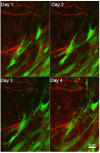Towards extracellular matrix normalization for improved treatment of solid tumors
- PMID: 32042347
- PMCID: PMC6993244
- DOI: 10.7150/thno.39995
Towards extracellular matrix normalization for improved treatment of solid tumors
Abstract
It is currently challenging to eradicate cancer. In the case of solid tumors, the dense and aberrant extracellular matrix (ECM) is a major contributor to the heterogeneous distribution of small molecule drugs and nano-formulations, which makes certain areas of the tumor difficult to treat. As such, much research is devoted to characterizing this matrix and devising strategies to modify its properties as a means to facilitate the improved penetration of drugs and their nano-formulations. This contribution presents the current state of knowledge on the composition of normal ECM and changes to ECM that occur during the pathological progression of cancer. It also includes discussion of strategies designed to modify the composition/properties of the ECM as a means to enhance the penetration and transport of drugs and nano-formulations within solid tumors. Moreover, a discussion of approaches to image the ECM, as well as ways to monitor changes in the ECM as a function of time are presented, as these are important for the implementation of ECM-modifying strategies within therapeutic interventions. Overall, considering the complexity of the ECM, its variability within different tissues, and the multiple pathways by which homeostasis is maintained (both in normal and malignant tissues), the available literature - while promising - suggests that improved monitoring of ECM remodeling in vivo is needed to harness the described strategies to their full potential, and match them with an appropriate chemotherapy regimen.
Keywords: collagen; fibrosis; hyaluronic acid; nano-formulations; tumor extracellular matrix.
© The author(s).
Conflict of interest statement
Competing Interests: The authors have declared that no competing interest exists.
Figures







Similar articles
-
Remodeling and homeostasis of the extracellular matrix: implications for fibrotic diseases and cancer.Dis Model Mech. 2011 Mar;4(2):165-78. doi: 10.1242/dmm.004077. Epub 2011 Feb 14. Dis Model Mech. 2011. PMID: 21324931 Free PMC article.
-
Digesting a Path Forward: The Utility of Collagenase Tumor Treatment for Improved Drug Delivery.Mol Pharm. 2018 Jun 4;15(6):2069-2083. doi: 10.1021/acs.molpharmaceut.8b00319. Epub 2018 May 16. Mol Pharm. 2018. PMID: 29767984 Free PMC article. Review.
-
The Complex Interplay Between Extracellular Matrix and Cells in Tissues.Methods Mol Biol. 2019;1952:1-20. doi: 10.1007/978-1-4939-9133-4_1. Methods Mol Biol. 2019. PMID: 30825161 Review.
-
Targeting tumor extracellular matrix with nanoparticles to circumvent therapeutic resistance.J Control Release. 2025 Jul 10;383:113786. doi: 10.1016/j.jconrel.2025.113786. Epub 2025 Apr 28. J Control Release. 2025. PMID: 40306575 Review.
-
Dynamic matrisome: ECM remodeling factors licensing cancer progression and metastasis.Biochim Biophys Acta Rev Cancer. 2018 Dec;1870(2):207-228. doi: 10.1016/j.bbcan.2018.09.002. Epub 2018 Oct 12. Biochim Biophys Acta Rev Cancer. 2018. PMID: 30316942 Review.
Cited by
-
Tumor-on-a-chip model for advancement of anti-cancer nano drug delivery system.J Nanobiotechnology. 2022 Jul 20;20(1):338. doi: 10.1186/s12951-022-01552-0. J Nanobiotechnology. 2022. PMID: 35858898 Free PMC article. Review.
-
Role of extracellular matrix architecture and signaling in melanoma therapeutic resistance.Front Oncol. 2022 Sep 2;12:924553. doi: 10.3389/fonc.2022.924553. eCollection 2022. Front Oncol. 2022. PMID: 36119516 Free PMC article. Review.
-
A 3D culture system for evaluating the combined effects of cisplatin and anti-fibrotic drugs on the growth and invasion of lung cancer cells co-cultured with fibroblasts.APL Bioeng. 2023 Mar 28;7(1):016117. doi: 10.1063/5.0115464. eCollection 2023 Mar. APL Bioeng. 2023. PMID: 37006781 Free PMC article.
-
Unlocking Nature's Potential: Ferritin as a Universal Nanocarrier for Amplified Cancer Therapy Testing via 3D Microtissues.ACS Appl Mater Interfaces. 2024 Dec 25;16(51):70187-70204. doi: 10.1021/acsami.4c12524. Epub 2024 Dec 11. ACS Appl Mater Interfaces. 2024. PMID: 39660468 Free PMC article.
-
Multiregion single cell analysis reveals a novel subtype of cancer-associated fibroblasts located in the hypoxic tumor microenvironment in colorectal cancer.Transl Oncol. 2023 Jan;27:101570. doi: 10.1016/j.tranon.2022.101570. Epub 2022 Nov 10. Transl Oncol. 2023. PMID: 36371957 Free PMC article.
References
-
- Trédan O, Galmarini CM, Patel K, Tannock IF. Drug Resistance and the Solid Tumor Microenvironment. J Natl Cancer Inst. 2007;99:1441–54. - PubMed
-
- Maeda H, Tsukigawa K, Fang J. A Retrospective 30 Years After Discovery of the Enhanced Permeability and Retention Effect of Solid Tumors: Next-Generation Chemotherapeutics and Photodynamic Therapy—Problems, Solutions, and Prospects. Microcirculation. 2016;23:173–82. - PubMed
Publication types
MeSH terms
Substances
LinkOut - more resources
Full Text Sources
Medical
Research Materials

